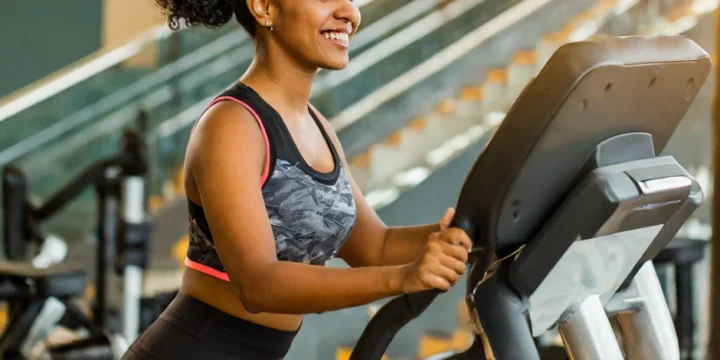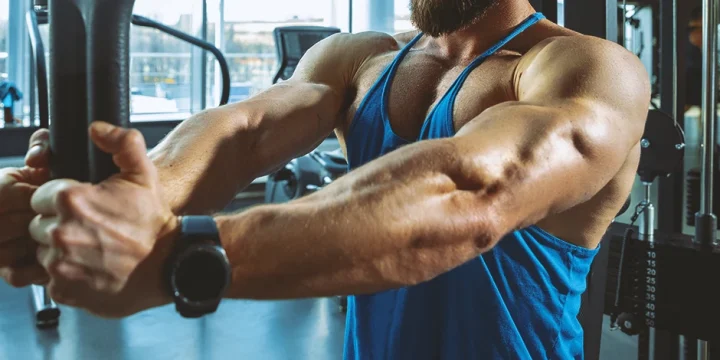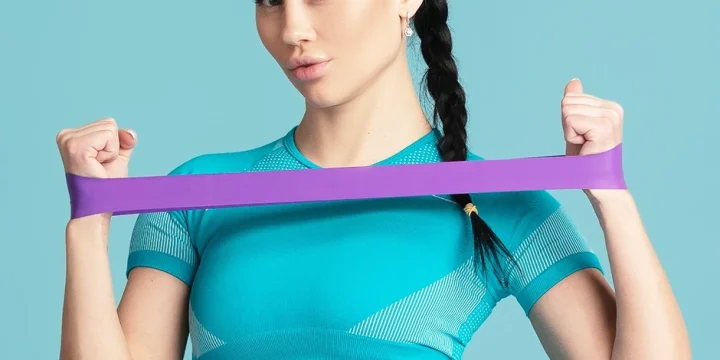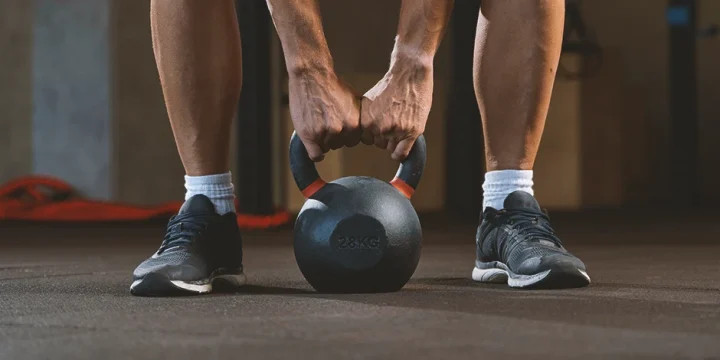Squats with resistance bands add an extra resistance dimension to the conventional squat.
This exercise bolsters your training and broadens its scope, stimulating a larger muscle group.
They merge strength training and flexibility, making it a superb choice for those seeking to optimize their routines.
Using resistance bands in workouts, I've found they offer comprehensive benefits, ideal for multifaceted training.
This article shares insights on maximizing glute muscle training with resistance band squats.
Quick Summary
- To enhance your squat routine, incorporate resistance bands for added tension, targeting a broader range of muscles and improving strength and flexibility.
- Various squat exercises with resistance bands, including banded sumo squats, goblet squats, pulse squats, and more, each targeting specific muscle groups.
- Resistance band squats offer enhanced muscle engagement, improved balance and coordination, and are joint-friendly, making them suitable for all fitness levels.
- In my experience, incorporating resistance bands into squat exercises significantly boosts lower body strength and flexibility, making it a versatile addition to any workout regimen.
How To Do Resistance Band Squats?

Resistance band squats work by adding a training band to your squat position.
You must pick one that increases resistance and forces you to perform slowly while keeping a correct form.
This functional movement mimics everyday actions, improving your mobility and balance, as confirmed by the study published on the ResearchGate [1].
How to perform squats with resistance bands:
- Select a loop band with moderate resistance. It must challenge you but not compromise the squat’s motion.
- Slip the band just above your knees. Make sure it's secure but tight enough.
- Stand tall, feet shoulder-width apart, toes slightly pointed outward. This is your starting position.
- Lower your body while performing banded squats, keeping the chest lifted. Press your knees against the band to keep them from caving in.
- Drive through your heels, ensuring the band's tension throughout the movement.
Resistance Band Squats Variations

Below you can find squat exercise variations that I’ve tried to test the resistance band’s efficiency [2].Enhancing muscle activation and increasing workout intensity for better results.
Banded Sumo Squat
The banded sumo squat exercise targets the inner thighs and glutes more effectively due to the wider stance.
The band increases resistance, encouraging muscle engagement throughout the entire motion.
How to do it:
- Stand with your feet at shoulder-width apart, toes pointed outwards.
- Place a resistance band above your knees.
- Lower into a squat, pushing your hips back and lifting your chest.
- Push back up through your heels, feeling the resistance band as you rise.
- Repeat for the desired number of reps.
Related: Sumo vs Conventional Deadlift
Banded Goblet Squat
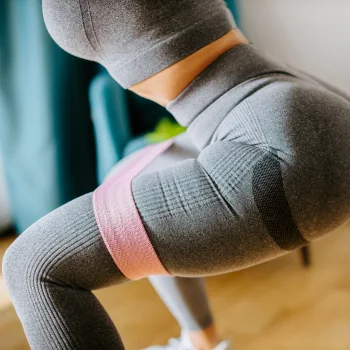
This squat variation is a full-body movement that works your quads, glutes, and core.
The added resistance band helps with form and intensifies lower-body workouts.
How to do it:
- Stand with feet hip-width apart. Hold a kettlebell or dumbbell in the chest position.
- Place a resistance band above your knees.
- Squat down, keeping your chest up, and then push back up to standing, maintaining tension in the band.
- Repeat for the desired number of reps.
Also Read: Crush Grip Goblet Squat
Banded Pulse Squat
Banded pulse squats increase time under tension, leading to greater muscle fatigue and growth.
The band adds an extra challenge to your glute and thigh muscles.
How to do it:
- Place a resistance band above your knees. Stand with your feet shoulder-width apart.
- Lower into a squat position and then pulse up and down, keeping tension in the band.
- Continue pulsing for the desired number of reps.
Banded Lateral Leg Raise Squat
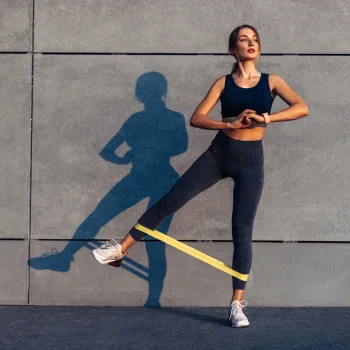
Banded lateral leg raise squats target quads and glutes, improve hip mobility, and strengthen the gluteus medius.
It improves hip stability, an essential aspect of athletic activities.
How to do it:
- Position a resistance band above your knees. Align your feet hip-width apart.
- Perform a full squat, ensuring your knees do not buckle inward, with your weight on your heels and your chest upright.
- As you stand up, transfer weight to one leg while lifting the other sideways in a controlled motion against the band's resistance.
- Return the raised leg to the initial position, squat again, and repeat the leg lift on the other side.
- Continue this sequence for the desired reps, maintaining continuous tension on the band.
Banded Split Squat
The banded split squat is an asymmetrical workout targeting each leg.
It effectively strengthens the quads, glutes, and hamstrings while promoting balance and coordination, which are crucial for overall muscular functionality.
How to do it:
- Step onto a resistance band with your front foot in a staggered stance. Hold the other end at shoulder height.
- Lower your body steadily into a lunge, maintaining an upright torso and ensuring the front knee doesn't go past your toes.
- Push through your front heel, engaging your quads and glutes.
- Complete the desired reps, then switch your stance to work the other leg.
Anchored Squat

Anchored squats are a unique squat variant where the band, tethered to a solid post, introduces a specific resistance direction.
This exercise boosts traditional squat muscle strength and enhances balance and coordination for better body stability.
How to do it:
- Fasten a resistance band to a sturdy post or anchor point. Grasp the other end with both hands.
- Step back to increase the band's tension. Stand with your feet shoulder-width apart.
- Lower your body into a squat, lifting your chest and back straight during this workout.
- Push through your heels, using the band's resistance to return to the starting position.
- Complete the prescribed number of repetitions, maintaining a consistent band tension throughout.
Barbell Banded Squat
Barbell squats with a band increase resistance, especially as you stand and stretch the band. This improves strength and power, especially in the "lockout" part of the lift [3].
How to do it:
- Securely attach a resistance band to each end of the barbell and an anchor point on the floor.
- Position yourself under the barbell with a standard squat stance.
- Lower your body into a squat, then push through your heels to rise back up, feeling the increased resistance as you stand.
- Repeat maintaining control and proper form throughout.
Lateral Band Walk
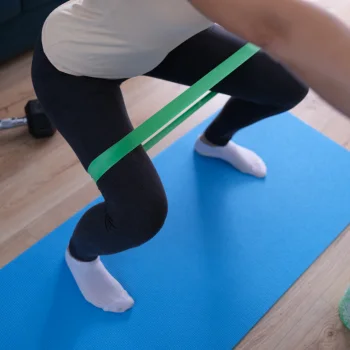
Lateral band walks are a popular supplemental exercise to squats, typically included in lower-body training routines.
This exercise specifically targets the gluteus medius, glutes, and assists in improving hip stability.
How to do it:
- With a resistance band around your thighs above the knees, assume a half-squat position.
- Step sideways, maintaining tension on the band, then follow with the other foot.
- Continue sidestepping for a set number of steps, then reverse direction.
- Keep your half-squat stance and the band tension throughout the exercise.
Leg Workout Routine Using Bands

This workout routine includes various resistance band squats for a comprehensive lower-body workout, enhancing muscle activation and flexibility.
Workout:
- Banded Sumo Squats: 3 sets of 12-15 reps.
- Banded Goblet Squats: 3 sets of 12-15 reps.
- Banded Pulse Squats: 3 sets of 20 pulses.
- Banded Lateral Leg Raise Squats: 3 sets of 10-12 reps on each side.
- Banded Split Squats: 3 sets of 10-12 reps for each leg.
- Anchored Squats: 3 sets of 12-15 reps.
- Barbell Banded Squats: 3 sets of 8-10 reps.
- Lateral Band Walk: 3 sets of 10-12 steps on each side.
"Squats with resistance bands are a great way to challenge your muscles and improve your strength and fitness."
- Jeff Cavaliere, Certified Personal Trainer & Founder of Athlean-X
Why Combine Squats with Resistance Bands?

Combine squats with resistance bands for added resistance, suitable for lightweight or bodyweight squats.
They elevate your squat and upper body game [4].
Here's why incorporating resistance bands into your squat routine is a smart move:
- Resistance bands work your muscles all through the squat movement.
- Bands add more resistance at the top of your squat.
- They help you maintain form, boosting your core engagement, balance, and stability.
- They offer different tension levels and are easy to carry. Perfect for on-the-go workouts and customizing your routine.
- Compared to weights, bands go easy on your joints.
Benefits of Using Bands while Performing Squats

Here are four benefits when using resistance bands:
- Enhanced Muscle Engagement: The constant tension from resistance bands engages your stabilizing and target muscles.
- Versatile and Adaptable: Resistance bands come in various levels, allowing exercise adaptability. This makes them suitable for beginners, advanced athletes, and those in rehabilitation.
- Lower Impact on Joints: Squatting with resistance bands is more joint-friendly than lifting heavy weights. This low-impact nature makes it a safer exercise option, minimizing the risk of injury. It's ideal for all ages and fitness levels.
- Improved Mobility and Flexibility: Resistance bands naturally encourage a full range of motion. When incorporated into your workout routine, this improves your mobility and flexibility over time.
Common Band Mistakes in Squat Trainings

When training squats with resistance bands, common mistakes can hinder progress and potentially lead to injury. In my experience, ensuring proper band placement and maintaining correct posture are crucial to avoid these issues and achieve effective results.
Here are a few to avoid:
- If the band is too high or low on your legs, it can slide during the exercise. Keep the band just above the knees to maintain stability.
- Ignoring proper squat form reduces the effectiveness of the workout and risks injury.
- Using a band that's too light won't provide adequate resistance, while a band that's too heavy can compromise your form. Use progressive overload to get used to each band you use.
- Perform squats slowly. Rushing may lead to improper form and less effective muscle engagement.
"Resistance band squats are a safe and effective way to work your legs, glutes, and core. They're also a great option for people who have limited access to gym equipment."
- Jessica Jones, Certified Personal Trainer & Founder of The Fit Mother Project
FAQs
Can I Replace Weights With Resistance Bands in My Squat Workout?
Yes, you can replace weights with resistance bands in your squat workout. Offer constant tension, targeting muscles uniquely.
How do Bands Help With Squats?
Bands help with squats by providing variable resistance, intensifying the workout as you rise from a squat. They also encourage proper form, preventing your knees from caving inward.
How Do Resistance Bands Improve Squat Exercises?
Resistance bands improve squat exercises by adding a different tension type, particularly during the 'lockout' phase. This extra challenge promotes strength, flexibility, and stability while improving form.
References:
- https://www.researchgate.net/publication/342816111
- https://www.researchgate.net/publication/317670213
- https://www.researchgate.net/publication/339045571
- https://www.researchgate.net/publication/262385394
About The Author
You May Also Like
